Epidemiology Report: Dietary Factors and Esophageal Cancer Risk
VerifiedAdded on 2020/05/03
|11
|3111
|44
Report
AI Summary
This report explores the relationship between dietary factors and the risk of adenocarcinoma of the esophagus and gastric cardia. The study, conducted on a Swedish population, employed a case-control design with participants diagnosed with adenocarcinoma esophagus and gastric cardia, alongside a control group. The research investigated the association between the intake of various foods, such as chocolates, coffee, tomatoes, and citrus fruits, and the occurrence of reflux symptoms, a known risk factor for these cancers. The study involved face-to-face interviews using a structured questionnaire to gather dietary information over a 20-year period. The findings indicated no significant association between dietary habits and the risk of the two cancer types, although the study acknowledges potential limitations in the study design and the nature of reflux. It concludes that, based on the data, there is no need for public health concerns regarding the general consumption of foods that promote reflux.
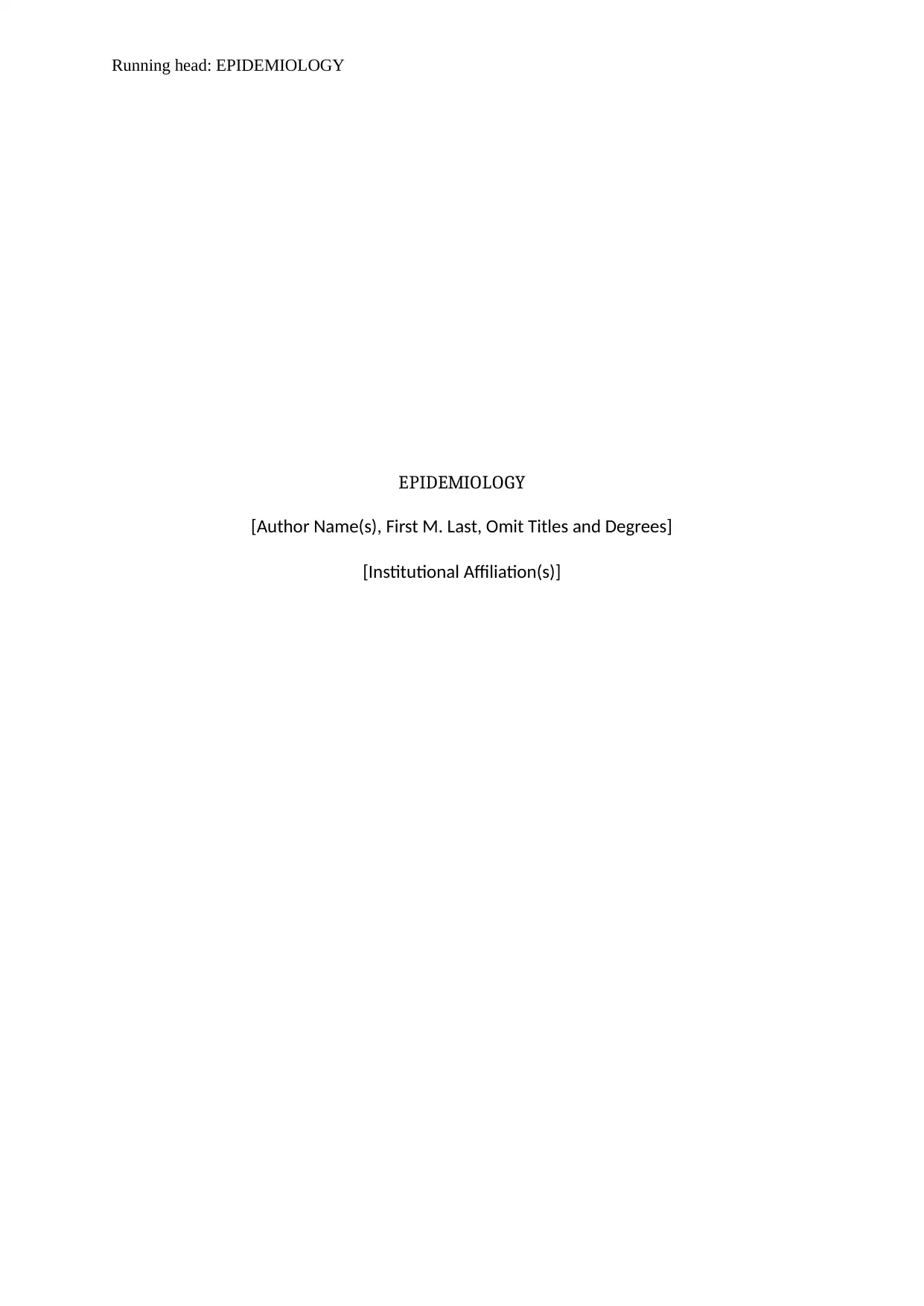
Running head: EPIDEMIOLOGY
EPIDEMIOLOGY
[Author Name(s), First M. Last, Omit Titles and Degrees]
[Institutional Affiliation(s)]
EPIDEMIOLOGY
[Author Name(s), First M. Last, Omit Titles and Degrees]
[Institutional Affiliation(s)]
Paraphrase This Document
Need a fresh take? Get an instant paraphrase of this document with our AI Paraphraser
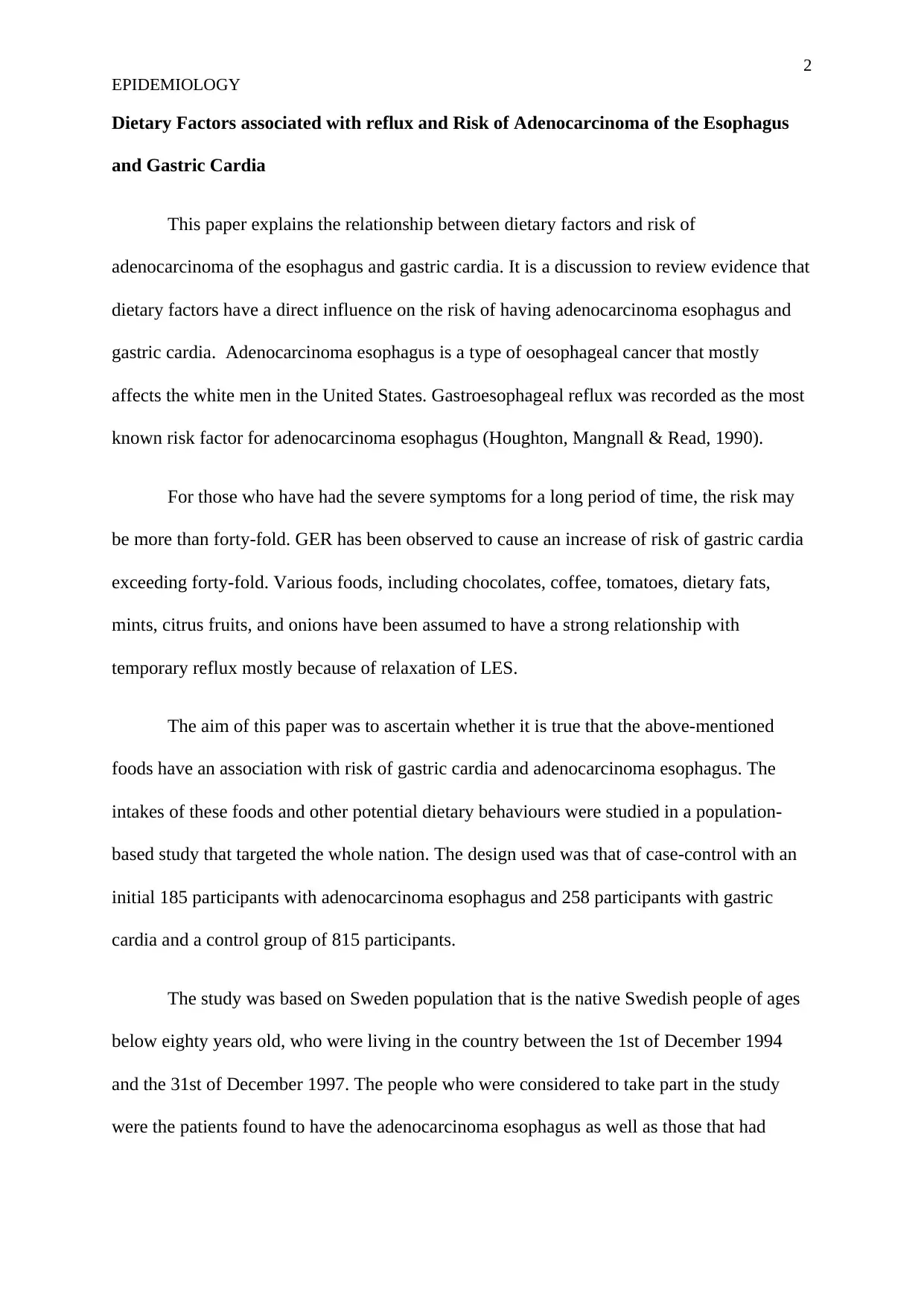
2
EPIDEMIOLOGY
Dietary Factors associated with reflux and Risk of Adenocarcinoma of the Esophagus
and Gastric Cardia
This paper explains the relationship between dietary factors and risk of
adenocarcinoma of the esophagus and gastric cardia. It is a discussion to review evidence that
dietary factors have a direct influence on the risk of having adenocarcinoma esophagus and
gastric cardia. Adenocarcinoma esophagus is a type of oesophageal cancer that mostly
affects the white men in the United States. Gastroesophageal reflux was recorded as the most
known risk factor for adenocarcinoma esophagus (Houghton, Mangnall & Read, 1990).
For those who have had the severe symptoms for a long period of time, the risk may
be more than forty-fold. GER has been observed to cause an increase of risk of gastric cardia
exceeding forty-fold. Various foods, including chocolates, coffee, tomatoes, dietary fats,
mints, citrus fruits, and onions have been assumed to have a strong relationship with
temporary reflux mostly because of relaxation of LES.
The aim of this paper was to ascertain whether it is true that the above-mentioned
foods have an association with risk of gastric cardia and adenocarcinoma esophagus. The
intakes of these foods and other potential dietary behaviours were studied in a population-
based study that targeted the whole nation. The design used was that of case-control with an
initial 185 participants with adenocarcinoma esophagus and 258 participants with gastric
cardia and a control group of 815 participants.
The study was based on Sweden population that is the native Swedish people of ages
below eighty years old, who were living in the country between the 1st of December 1994
and the 31st of December 1997. The people who were considered to take part in the study
were the patients found to have the adenocarcinoma esophagus as well as those that had
EPIDEMIOLOGY
Dietary Factors associated with reflux and Risk of Adenocarcinoma of the Esophagus
and Gastric Cardia
This paper explains the relationship between dietary factors and risk of
adenocarcinoma of the esophagus and gastric cardia. It is a discussion to review evidence that
dietary factors have a direct influence on the risk of having adenocarcinoma esophagus and
gastric cardia. Adenocarcinoma esophagus is a type of oesophageal cancer that mostly
affects the white men in the United States. Gastroesophageal reflux was recorded as the most
known risk factor for adenocarcinoma esophagus (Houghton, Mangnall & Read, 1990).
For those who have had the severe symptoms for a long period of time, the risk may
be more than forty-fold. GER has been observed to cause an increase of risk of gastric cardia
exceeding forty-fold. Various foods, including chocolates, coffee, tomatoes, dietary fats,
mints, citrus fruits, and onions have been assumed to have a strong relationship with
temporary reflux mostly because of relaxation of LES.
The aim of this paper was to ascertain whether it is true that the above-mentioned
foods have an association with risk of gastric cardia and adenocarcinoma esophagus. The
intakes of these foods and other potential dietary behaviours were studied in a population-
based study that targeted the whole nation. The design used was that of case-control with an
initial 185 participants with adenocarcinoma esophagus and 258 participants with gastric
cardia and a control group of 815 participants.
The study was based on Sweden population that is the native Swedish people of ages
below eighty years old, who were living in the country between the 1st of December 1994
and the 31st of December 1997. The people who were considered to take part in the study
were the patients found to have the adenocarcinoma esophagus as well as those that had
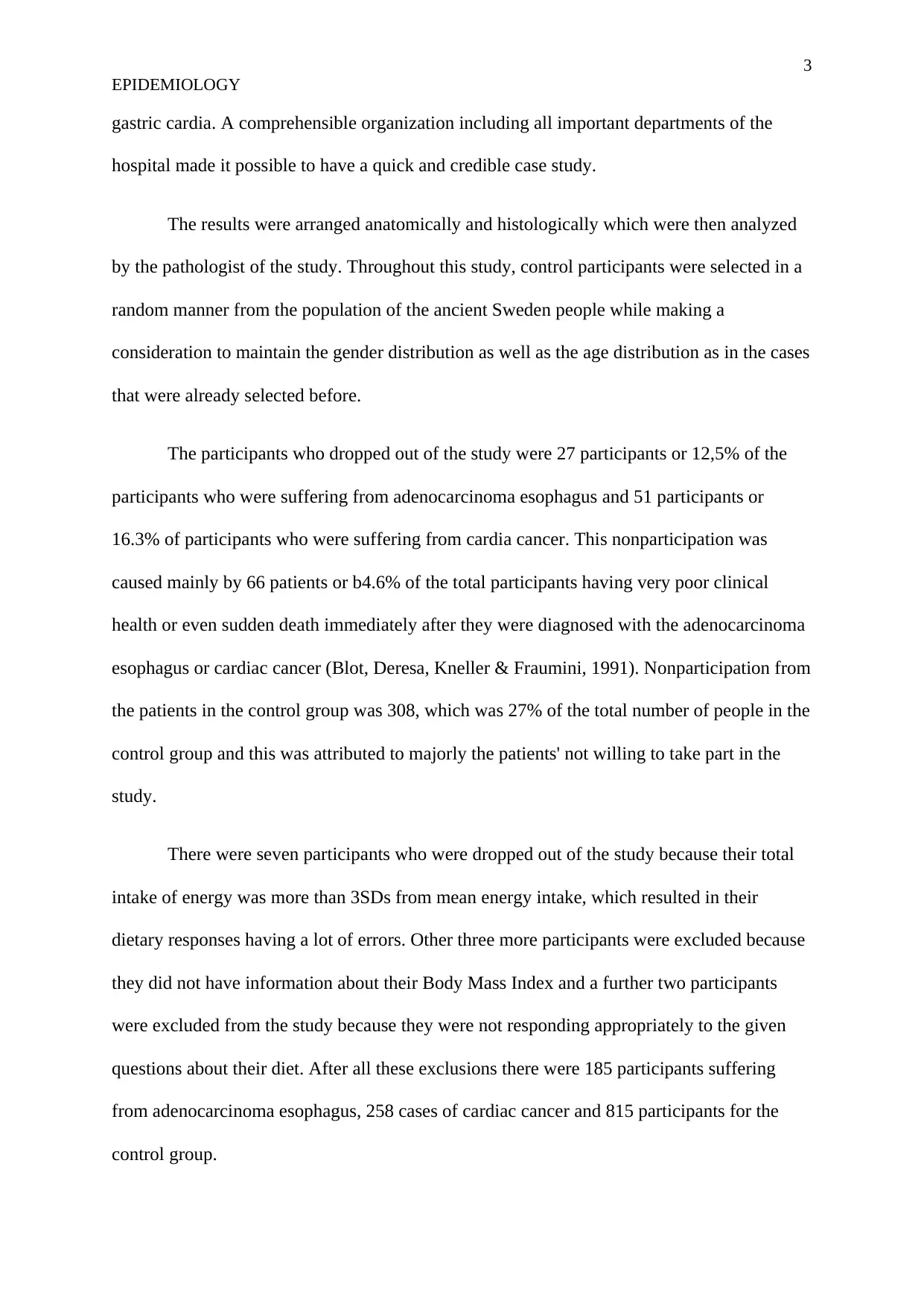
3
EPIDEMIOLOGY
gastric cardia. A comprehensible organization including all important departments of the
hospital made it possible to have a quick and credible case study.
The results were arranged anatomically and histologically which were then analyzed
by the pathologist of the study. Throughout this study, control participants were selected in a
random manner from the population of the ancient Sweden people while making a
consideration to maintain the gender distribution as well as the age distribution as in the cases
that were already selected before.
The participants who dropped out of the study were 27 participants or 12,5% of the
participants who were suffering from adenocarcinoma esophagus and 51 participants or
16.3% of participants who were suffering from cardia cancer. This nonparticipation was
caused mainly by 66 patients or b4.6% of the total participants having very poor clinical
health or even sudden death immediately after they were diagnosed with the adenocarcinoma
esophagus or cardiac cancer (Blot, Deresa, Kneller & Fraumini, 1991). Nonparticipation from
the patients in the control group was 308, which was 27% of the total number of people in the
control group and this was attributed to majorly the patients' not willing to take part in the
study.
There were seven participants who were dropped out of the study because their total
intake of energy was more than 3SDs from mean energy intake, which resulted in their
dietary responses having a lot of errors. Other three more participants were excluded because
they did not have information about their Body Mass Index and a further two participants
were excluded from the study because they were not responding appropriately to the given
questions about their diet. After all these exclusions there were 185 participants suffering
from adenocarcinoma esophagus, 258 cases of cardiac cancer and 815 participants for the
control group.
EPIDEMIOLOGY
gastric cardia. A comprehensible organization including all important departments of the
hospital made it possible to have a quick and credible case study.
The results were arranged anatomically and histologically which were then analyzed
by the pathologist of the study. Throughout this study, control participants were selected in a
random manner from the population of the ancient Sweden people while making a
consideration to maintain the gender distribution as well as the age distribution as in the cases
that were already selected before.
The participants who dropped out of the study were 27 participants or 12,5% of the
participants who were suffering from adenocarcinoma esophagus and 51 participants or
16.3% of participants who were suffering from cardia cancer. This nonparticipation was
caused mainly by 66 patients or b4.6% of the total participants having very poor clinical
health or even sudden death immediately after they were diagnosed with the adenocarcinoma
esophagus or cardiac cancer (Blot, Deresa, Kneller & Fraumini, 1991). Nonparticipation from
the patients in the control group was 308, which was 27% of the total number of people in the
control group and this was attributed to majorly the patients' not willing to take part in the
study.
There were seven participants who were dropped out of the study because their total
intake of energy was more than 3SDs from mean energy intake, which resulted in their
dietary responses having a lot of errors. Other three more participants were excluded because
they did not have information about their Body Mass Index and a further two participants
were excluded from the study because they were not responding appropriately to the given
questions about their diet. After all these exclusions there were 185 participants suffering
from adenocarcinoma esophagus, 258 cases of cardiac cancer and 815 participants for the
control group.
⊘ This is a preview!⊘
Do you want full access?
Subscribe today to unlock all pages.

Trusted by 1+ million students worldwide
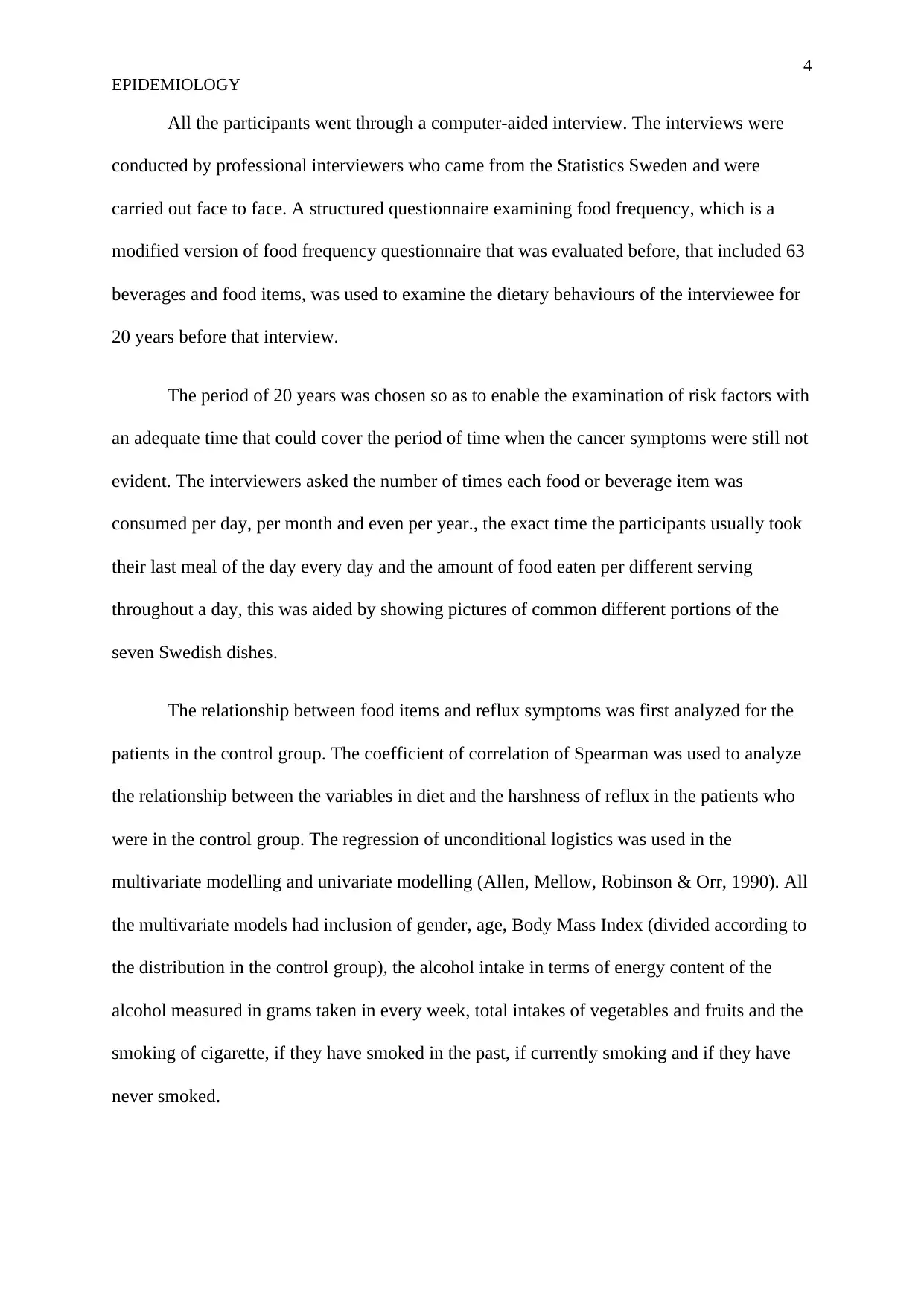
4
EPIDEMIOLOGY
All the participants went through a computer-aided interview. The interviews were
conducted by professional interviewers who came from the Statistics Sweden and were
carried out face to face. A structured questionnaire examining food frequency, which is a
modified version of food frequency questionnaire that was evaluated before, that included 63
beverages and food items, was used to examine the dietary behaviours of the interviewee for
20 years before that interview.
The period of 20 years was chosen so as to enable the examination of risk factors with
an adequate time that could cover the period of time when the cancer symptoms were still not
evident. The interviewers asked the number of times each food or beverage item was
consumed per day, per month and even per year., the exact time the participants usually took
their last meal of the day every day and the amount of food eaten per different serving
throughout a day, this was aided by showing pictures of common different portions of the
seven Swedish dishes.
The relationship between food items and reflux symptoms was first analyzed for the
patients in the control group. The coefficient of correlation of Spearman was used to analyze
the relationship between the variables in diet and the harshness of reflux in the patients who
were in the control group. The regression of unconditional logistics was used in the
multivariate modelling and univariate modelling (Allen, Mellow, Robinson & Orr, 1990). All
the multivariate models had inclusion of gender, age, Body Mass Index (divided according to
the distribution in the control group), the alcohol intake in terms of energy content of the
alcohol measured in grams taken in every week, total intakes of vegetables and fruits and the
smoking of cigarette, if they have smoked in the past, if currently smoking and if they have
never smoked.
EPIDEMIOLOGY
All the participants went through a computer-aided interview. The interviews were
conducted by professional interviewers who came from the Statistics Sweden and were
carried out face to face. A structured questionnaire examining food frequency, which is a
modified version of food frequency questionnaire that was evaluated before, that included 63
beverages and food items, was used to examine the dietary behaviours of the interviewee for
20 years before that interview.
The period of 20 years was chosen so as to enable the examination of risk factors with
an adequate time that could cover the period of time when the cancer symptoms were still not
evident. The interviewers asked the number of times each food or beverage item was
consumed per day, per month and even per year., the exact time the participants usually took
their last meal of the day every day and the amount of food eaten per different serving
throughout a day, this was aided by showing pictures of common different portions of the
seven Swedish dishes.
The relationship between food items and reflux symptoms was first analyzed for the
patients in the control group. The coefficient of correlation of Spearman was used to analyze
the relationship between the variables in diet and the harshness of reflux in the patients who
were in the control group. The regression of unconditional logistics was used in the
multivariate modelling and univariate modelling (Allen, Mellow, Robinson & Orr, 1990). All
the multivariate models had inclusion of gender, age, Body Mass Index (divided according to
the distribution in the control group), the alcohol intake in terms of energy content of the
alcohol measured in grams taken in every week, total intakes of vegetables and fruits and the
smoking of cigarette, if they have smoked in the past, if currently smoking and if they have
never smoked.
Paraphrase This Document
Need a fresh take? Get an instant paraphrase of this document with our AI Paraphraser
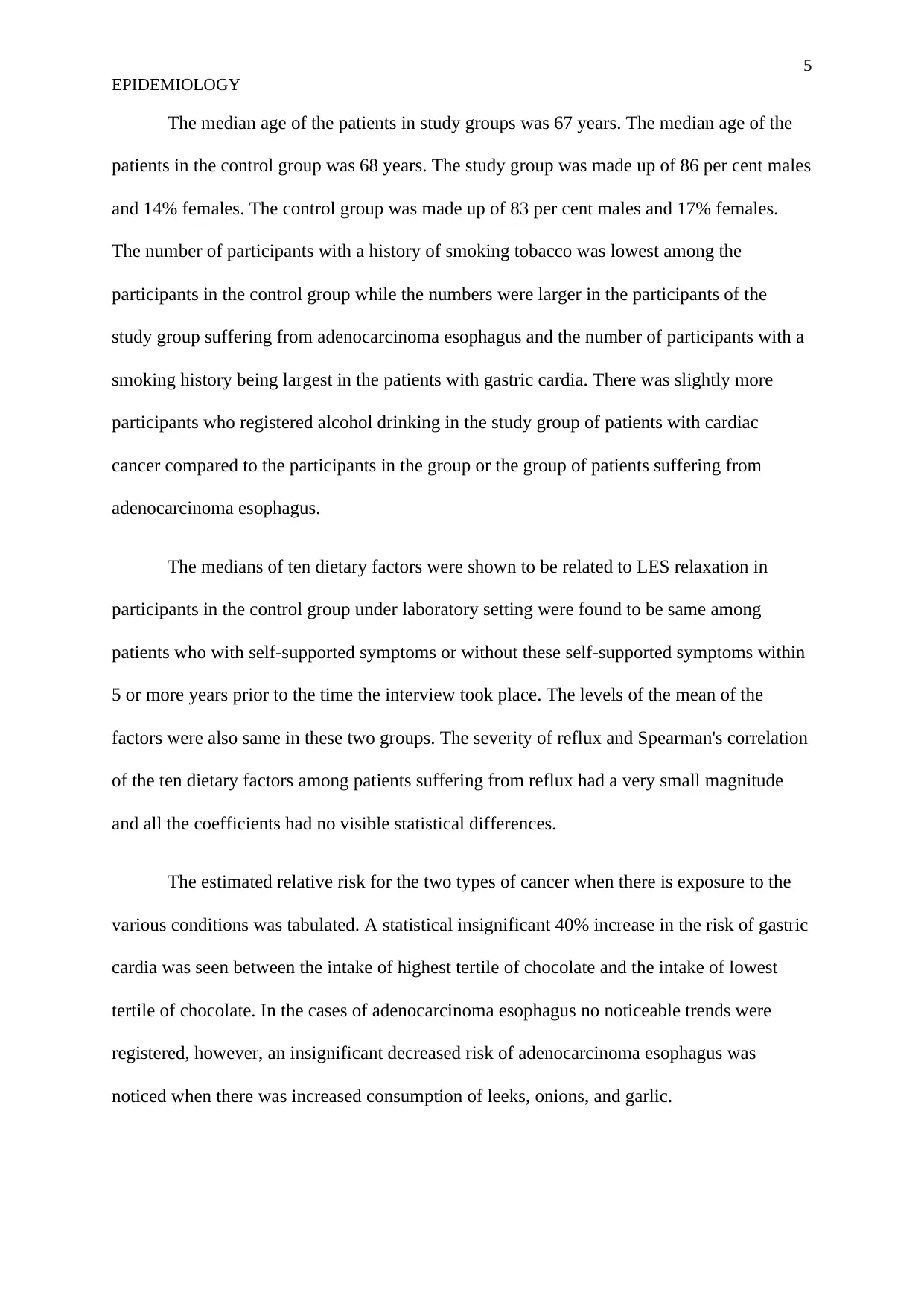
5
EPIDEMIOLOGY
The median age of the patients in study groups was 67 years. The median age of the
patients in the control group was 68 years. The study group was made up of 86 per cent males
and 14% females. The control group was made up of 83 per cent males and 17% females.
The number of participants with a history of smoking tobacco was lowest among the
participants in the control group while the numbers were larger in the participants of the
study group suffering from adenocarcinoma esophagus and the number of participants with a
smoking history being largest in the patients with gastric cardia. There was slightly more
participants who registered alcohol drinking in the study group of patients with cardiac
cancer compared to the participants in the group or the group of patients suffering from
adenocarcinoma esophagus.
The medians of ten dietary factors were shown to be related to LES relaxation in
participants in the control group under laboratory setting were found to be same among
patients who with self-supported symptoms or without these self-supported symptoms within
5 or more years prior to the time the interview took place. The levels of the mean of the
factors were also same in these two groups. The severity of reflux and Spearman's correlation
of the ten dietary factors among patients suffering from reflux had a very small magnitude
and all the coefficients had no visible statistical differences.
The estimated relative risk for the two types of cancer when there is exposure to the
various conditions was tabulated. A statistical insignificant 40% increase in the risk of gastric
cardia was seen between the intake of highest tertile of chocolate and the intake of lowest
tertile of chocolate. In the cases of adenocarcinoma esophagus no noticeable trends were
registered, however, an insignificant decreased risk of adenocarcinoma esophagus was
noticed when there was increased consumption of leeks, onions, and garlic.
EPIDEMIOLOGY
The median age of the patients in study groups was 67 years. The median age of the
patients in the control group was 68 years. The study group was made up of 86 per cent males
and 14% females. The control group was made up of 83 per cent males and 17% females.
The number of participants with a history of smoking tobacco was lowest among the
participants in the control group while the numbers were larger in the participants of the
study group suffering from adenocarcinoma esophagus and the number of participants with a
smoking history being largest in the patients with gastric cardia. There was slightly more
participants who registered alcohol drinking in the study group of patients with cardiac
cancer compared to the participants in the group or the group of patients suffering from
adenocarcinoma esophagus.
The medians of ten dietary factors were shown to be related to LES relaxation in
participants in the control group under laboratory setting were found to be same among
patients who with self-supported symptoms or without these self-supported symptoms within
5 or more years prior to the time the interview took place. The levels of the mean of the
factors were also same in these two groups. The severity of reflux and Spearman's correlation
of the ten dietary factors among patients suffering from reflux had a very small magnitude
and all the coefficients had no visible statistical differences.
The estimated relative risk for the two types of cancer when there is exposure to the
various conditions was tabulated. A statistical insignificant 40% increase in the risk of gastric
cardia was seen between the intake of highest tertile of chocolate and the intake of lowest
tertile of chocolate. In the cases of adenocarcinoma esophagus no noticeable trends were
registered, however, an insignificant decreased risk of adenocarcinoma esophagus was
noticed when there was increased consumption of leeks, onions, and garlic.
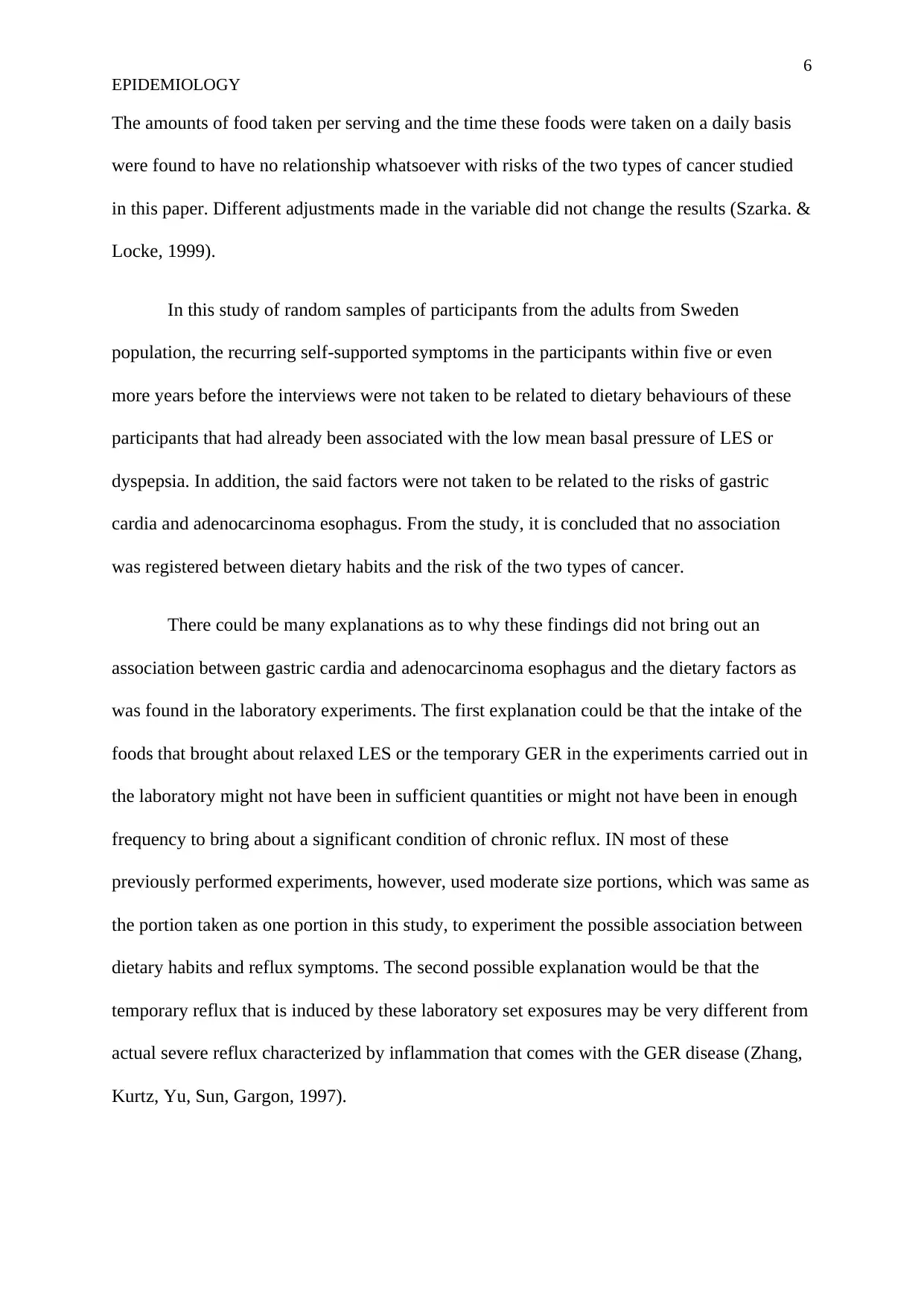
6
EPIDEMIOLOGY
The amounts of food taken per serving and the time these foods were taken on a daily basis
were found to have no relationship whatsoever with risks of the two types of cancer studied
in this paper. Different adjustments made in the variable did not change the results (Szarka. &
Locke, 1999).
In this study of random samples of participants from the adults from Sweden
population, the recurring self-supported symptoms in the participants within five or even
more years before the interviews were not taken to be related to dietary behaviours of these
participants that had already been associated with the low mean basal pressure of LES or
dyspepsia. In addition, the said factors were not taken to be related to the risks of gastric
cardia and adenocarcinoma esophagus. From the study, it is concluded that no association
was registered between dietary habits and the risk of the two types of cancer.
There could be many explanations as to why these findings did not bring out an
association between gastric cardia and adenocarcinoma esophagus and the dietary factors as
was found in the laboratory experiments. The first explanation could be that the intake of the
foods that brought about relaxed LES or the temporary GER in the experiments carried out in
the laboratory might not have been in sufficient quantities or might not have been in enough
frequency to bring about a significant condition of chronic reflux. IN most of these
previously performed experiments, however, used moderate size portions, which was same as
the portion taken as one portion in this study, to experiment the possible association between
dietary habits and reflux symptoms. The second possible explanation would be that the
temporary reflux that is induced by these laboratory set exposures may be very different from
actual severe reflux characterized by inflammation that comes with the GER disease (Zhang,
Kurtz, Yu, Sun, Gargon, 1997).
EPIDEMIOLOGY
The amounts of food taken per serving and the time these foods were taken on a daily basis
were found to have no relationship whatsoever with risks of the two types of cancer studied
in this paper. Different adjustments made in the variable did not change the results (Szarka. &
Locke, 1999).
In this study of random samples of participants from the adults from Sweden
population, the recurring self-supported symptoms in the participants within five or even
more years before the interviews were not taken to be related to dietary behaviours of these
participants that had already been associated with the low mean basal pressure of LES or
dyspepsia. In addition, the said factors were not taken to be related to the risks of gastric
cardia and adenocarcinoma esophagus. From the study, it is concluded that no association
was registered between dietary habits and the risk of the two types of cancer.
There could be many explanations as to why these findings did not bring out an
association between gastric cardia and adenocarcinoma esophagus and the dietary factors as
was found in the laboratory experiments. The first explanation could be that the intake of the
foods that brought about relaxed LES or the temporary GER in the experiments carried out in
the laboratory might not have been in sufficient quantities or might not have been in enough
frequency to bring about a significant condition of chronic reflux. IN most of these
previously performed experiments, however, used moderate size portions, which was same as
the portion taken as one portion in this study, to experiment the possible association between
dietary habits and reflux symptoms. The second possible explanation would be that the
temporary reflux that is induced by these laboratory set exposures may be very different from
actual severe reflux characterized by inflammation that comes with the GER disease (Zhang,
Kurtz, Yu, Sun, Gargon, 1997).
⊘ This is a preview!⊘
Do you want full access?
Subscribe today to unlock all pages.

Trusted by 1+ million students worldwide
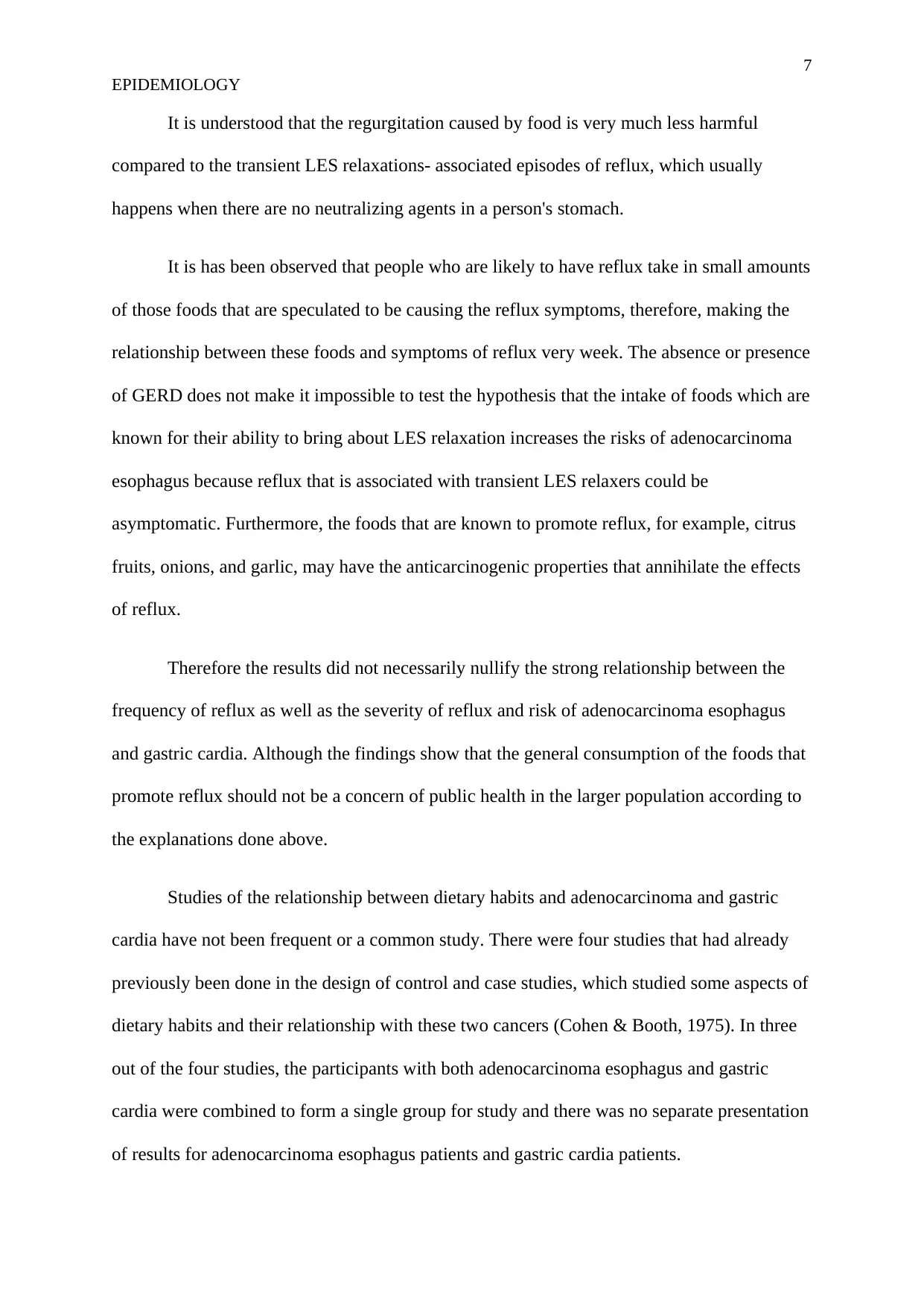
7
EPIDEMIOLOGY
It is understood that the regurgitation caused by food is very much less harmful
compared to the transient LES relaxations- associated episodes of reflux, which usually
happens when there are no neutralizing agents in a person's stomach.
It is has been observed that people who are likely to have reflux take in small amounts
of those foods that are speculated to be causing the reflux symptoms, therefore, making the
relationship between these foods and symptoms of reflux very week. The absence or presence
of GERD does not make it impossible to test the hypothesis that the intake of foods which are
known for their ability to bring about LES relaxation increases the risks of adenocarcinoma
esophagus because reflux that is associated with transient LES relaxers could be
asymptomatic. Furthermore, the foods that are known to promote reflux, for example, citrus
fruits, onions, and garlic, may have the anticarcinogenic properties that annihilate the effects
of reflux.
Therefore the results did not necessarily nullify the strong relationship between the
frequency of reflux as well as the severity of reflux and risk of adenocarcinoma esophagus
and gastric cardia. Although the findings show that the general consumption of the foods that
promote reflux should not be a concern of public health in the larger population according to
the explanations done above.
Studies of the relationship between dietary habits and adenocarcinoma and gastric
cardia have not been frequent or a common study. There were four studies that had already
previously been done in the design of control and case studies, which studied some aspects of
dietary habits and their relationship with these two cancers (Cohen & Booth, 1975). In three
out of the four studies, the participants with both adenocarcinoma esophagus and gastric
cardia were combined to form a single group for study and there was no separate presentation
of results for adenocarcinoma esophagus patients and gastric cardia patients.
EPIDEMIOLOGY
It is understood that the regurgitation caused by food is very much less harmful
compared to the transient LES relaxations- associated episodes of reflux, which usually
happens when there are no neutralizing agents in a person's stomach.
It is has been observed that people who are likely to have reflux take in small amounts
of those foods that are speculated to be causing the reflux symptoms, therefore, making the
relationship between these foods and symptoms of reflux very week. The absence or presence
of GERD does not make it impossible to test the hypothesis that the intake of foods which are
known for their ability to bring about LES relaxation increases the risks of adenocarcinoma
esophagus because reflux that is associated with transient LES relaxers could be
asymptomatic. Furthermore, the foods that are known to promote reflux, for example, citrus
fruits, onions, and garlic, may have the anticarcinogenic properties that annihilate the effects
of reflux.
Therefore the results did not necessarily nullify the strong relationship between the
frequency of reflux as well as the severity of reflux and risk of adenocarcinoma esophagus
and gastric cardia. Although the findings show that the general consumption of the foods that
promote reflux should not be a concern of public health in the larger population according to
the explanations done above.
Studies of the relationship between dietary habits and adenocarcinoma and gastric
cardia have not been frequent or a common study. There were four studies that had already
previously been done in the design of control and case studies, which studied some aspects of
dietary habits and their relationship with these two cancers (Cohen & Booth, 1975). In three
out of the four studies, the participants with both adenocarcinoma esophagus and gastric
cardia were combined to form a single group for study and there was no separate presentation
of results for adenocarcinoma esophagus patients and gastric cardia patients.
Paraphrase This Document
Need a fresh take? Get an instant paraphrase of this document with our AI Paraphraser
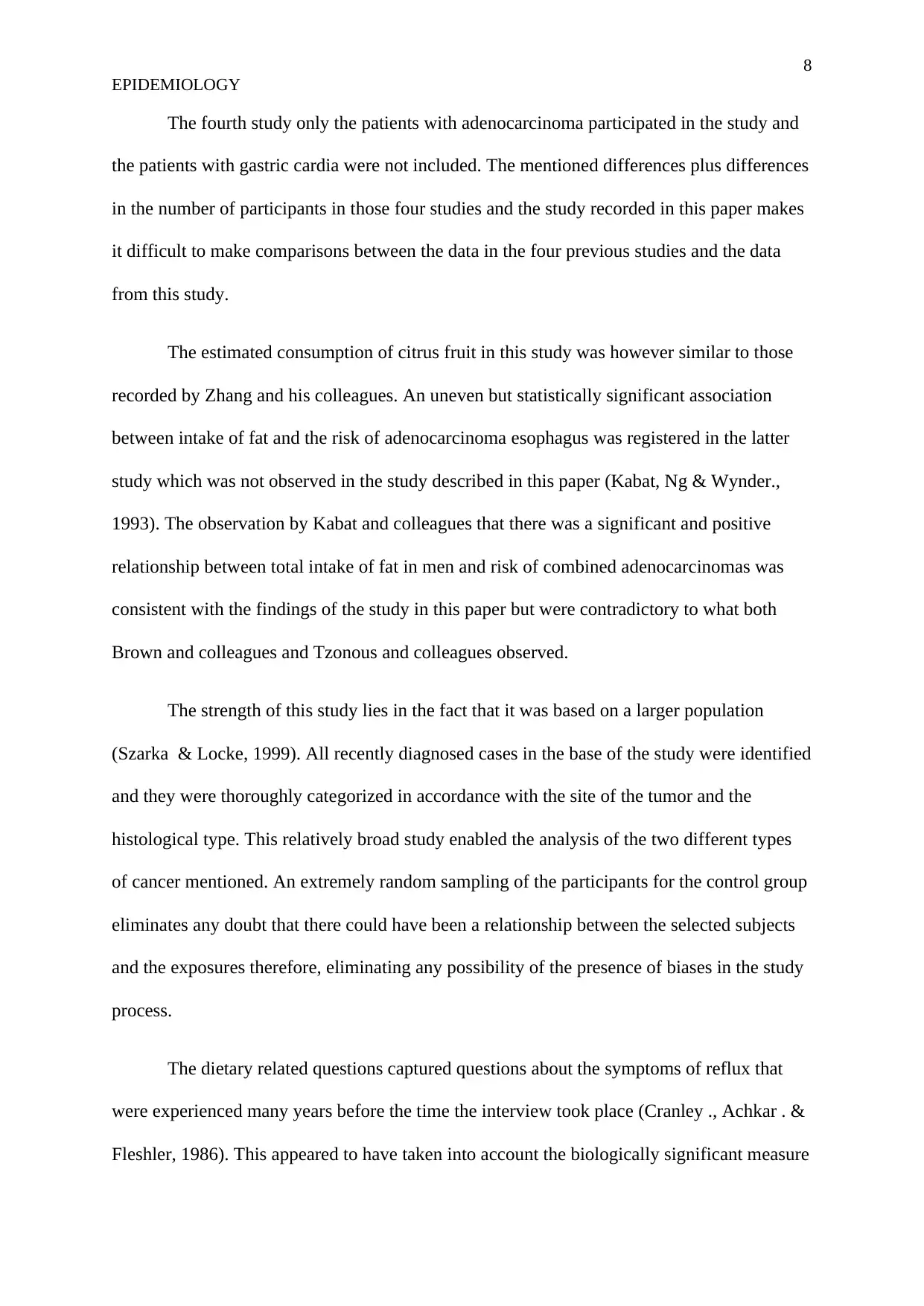
8
EPIDEMIOLOGY
The fourth study only the patients with adenocarcinoma participated in the study and
the patients with gastric cardia were not included. The mentioned differences plus differences
in the number of participants in those four studies and the study recorded in this paper makes
it difficult to make comparisons between the data in the four previous studies and the data
from this study.
The estimated consumption of citrus fruit in this study was however similar to those
recorded by Zhang and his colleagues. An uneven but statistically significant association
between intake of fat and the risk of adenocarcinoma esophagus was registered in the latter
study which was not observed in the study described in this paper (Kabat, Ng & Wynder.,
1993). The observation by Kabat and colleagues that there was a significant and positive
relationship between total intake of fat in men and risk of combined adenocarcinomas was
consistent with the findings of the study in this paper but were contradictory to what both
Brown and colleagues and Tzonous and colleagues observed.
The strength of this study lies in the fact that it was based on a larger population
(Szarka & Locke, 1999). All recently diagnosed cases in the base of the study were identified
and they were thoroughly categorized in accordance with the site of the tumor and the
histological type. This relatively broad study enabled the analysis of the two different types
of cancer mentioned. An extremely random sampling of the participants for the control group
eliminates any doubt that there could have been a relationship between the selected subjects
and the exposures therefore, eliminating any possibility of the presence of biases in the study
process.
The dietary related questions captured questions about the symptoms of reflux that
were experienced many years before the time the interview took place (Cranley ., Achkar . &
Fleshler, 1986). This appeared to have taken into account the biologically significant measure
EPIDEMIOLOGY
The fourth study only the patients with adenocarcinoma participated in the study and
the patients with gastric cardia were not included. The mentioned differences plus differences
in the number of participants in those four studies and the study recorded in this paper makes
it difficult to make comparisons between the data in the four previous studies and the data
from this study.
The estimated consumption of citrus fruit in this study was however similar to those
recorded by Zhang and his colleagues. An uneven but statistically significant association
between intake of fat and the risk of adenocarcinoma esophagus was registered in the latter
study which was not observed in the study described in this paper (Kabat, Ng & Wynder.,
1993). The observation by Kabat and colleagues that there was a significant and positive
relationship between total intake of fat in men and risk of combined adenocarcinomas was
consistent with the findings of the study in this paper but were contradictory to what both
Brown and colleagues and Tzonous and colleagues observed.
The strength of this study lies in the fact that it was based on a larger population
(Szarka & Locke, 1999). All recently diagnosed cases in the base of the study were identified
and they were thoroughly categorized in accordance with the site of the tumor and the
histological type. This relatively broad study enabled the analysis of the two different types
of cancer mentioned. An extremely random sampling of the participants for the control group
eliminates any doubt that there could have been a relationship between the selected subjects
and the exposures therefore, eliminating any possibility of the presence of biases in the study
process.
The dietary related questions captured questions about the symptoms of reflux that
were experienced many years before the time the interview took place (Cranley ., Achkar . &
Fleshler, 1986). This appeared to have taken into account the biologically significant measure
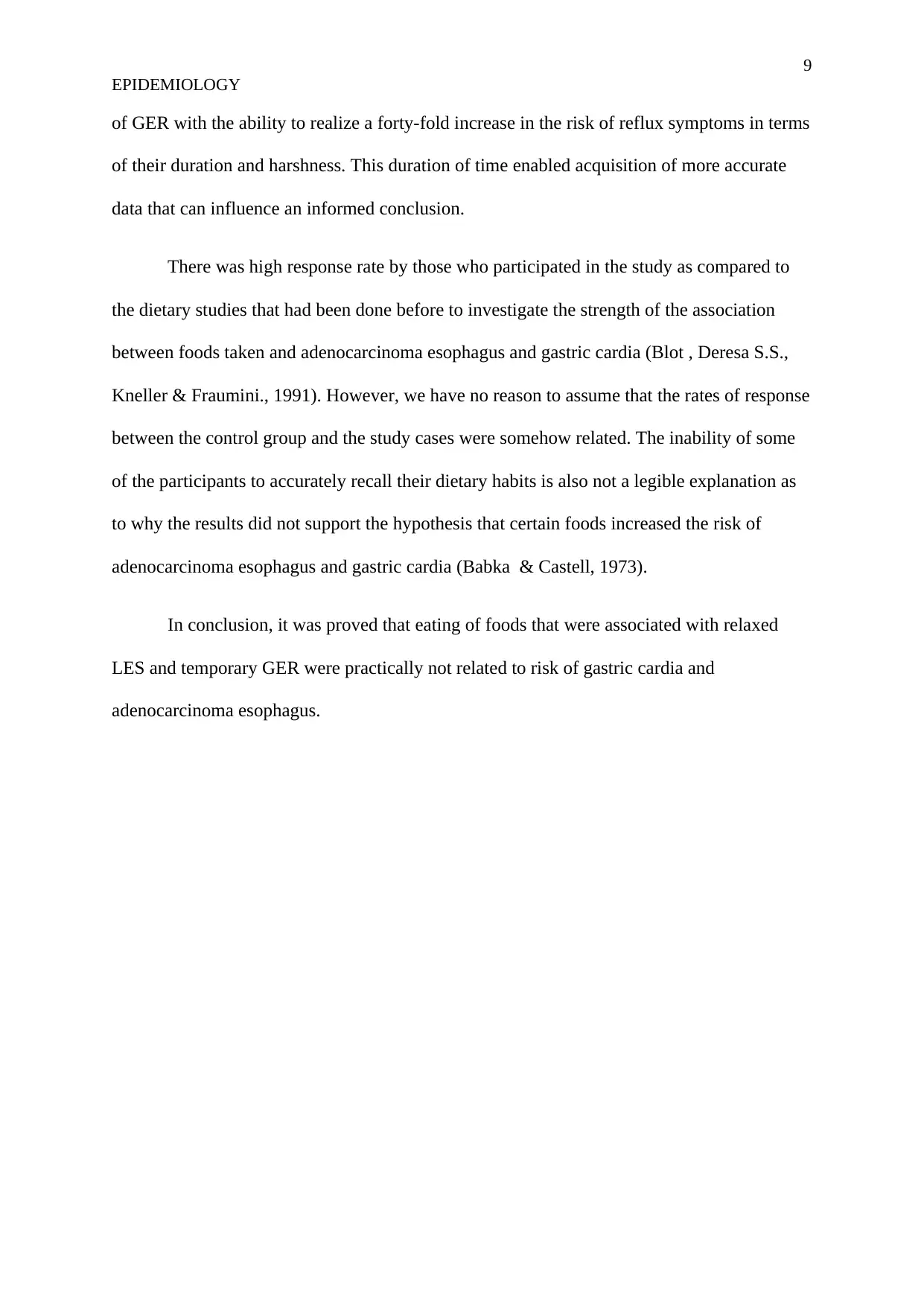
9
EPIDEMIOLOGY
of GER with the ability to realize a forty-fold increase in the risk of reflux symptoms in terms
of their duration and harshness. This duration of time enabled acquisition of more accurate
data that can influence an informed conclusion.
There was high response rate by those who participated in the study as compared to
the dietary studies that had been done before to investigate the strength of the association
between foods taken and adenocarcinoma esophagus and gastric cardia (Blot , Deresa S.S.,
Kneller & Fraumini., 1991). However, we have no reason to assume that the rates of response
between the control group and the study cases were somehow related. The inability of some
of the participants to accurately recall their dietary habits is also not a legible explanation as
to why the results did not support the hypothesis that certain foods increased the risk of
adenocarcinoma esophagus and gastric cardia (Babka & Castell, 1973).
In conclusion, it was proved that eating of foods that were associated with relaxed
LES and temporary GER were practically not related to risk of gastric cardia and
adenocarcinoma esophagus.
EPIDEMIOLOGY
of GER with the ability to realize a forty-fold increase in the risk of reflux symptoms in terms
of their duration and harshness. This duration of time enabled acquisition of more accurate
data that can influence an informed conclusion.
There was high response rate by those who participated in the study as compared to
the dietary studies that had been done before to investigate the strength of the association
between foods taken and adenocarcinoma esophagus and gastric cardia (Blot , Deresa S.S.,
Kneller & Fraumini., 1991). However, we have no reason to assume that the rates of response
between the control group and the study cases were somehow related. The inability of some
of the participants to accurately recall their dietary habits is also not a legible explanation as
to why the results did not support the hypothesis that certain foods increased the risk of
adenocarcinoma esophagus and gastric cardia (Babka & Castell, 1973).
In conclusion, it was proved that eating of foods that were associated with relaxed
LES and temporary GER were practically not related to risk of gastric cardia and
adenocarcinoma esophagus.
⊘ This is a preview!⊘
Do you want full access?
Subscribe today to unlock all pages.

Trusted by 1+ million students worldwide
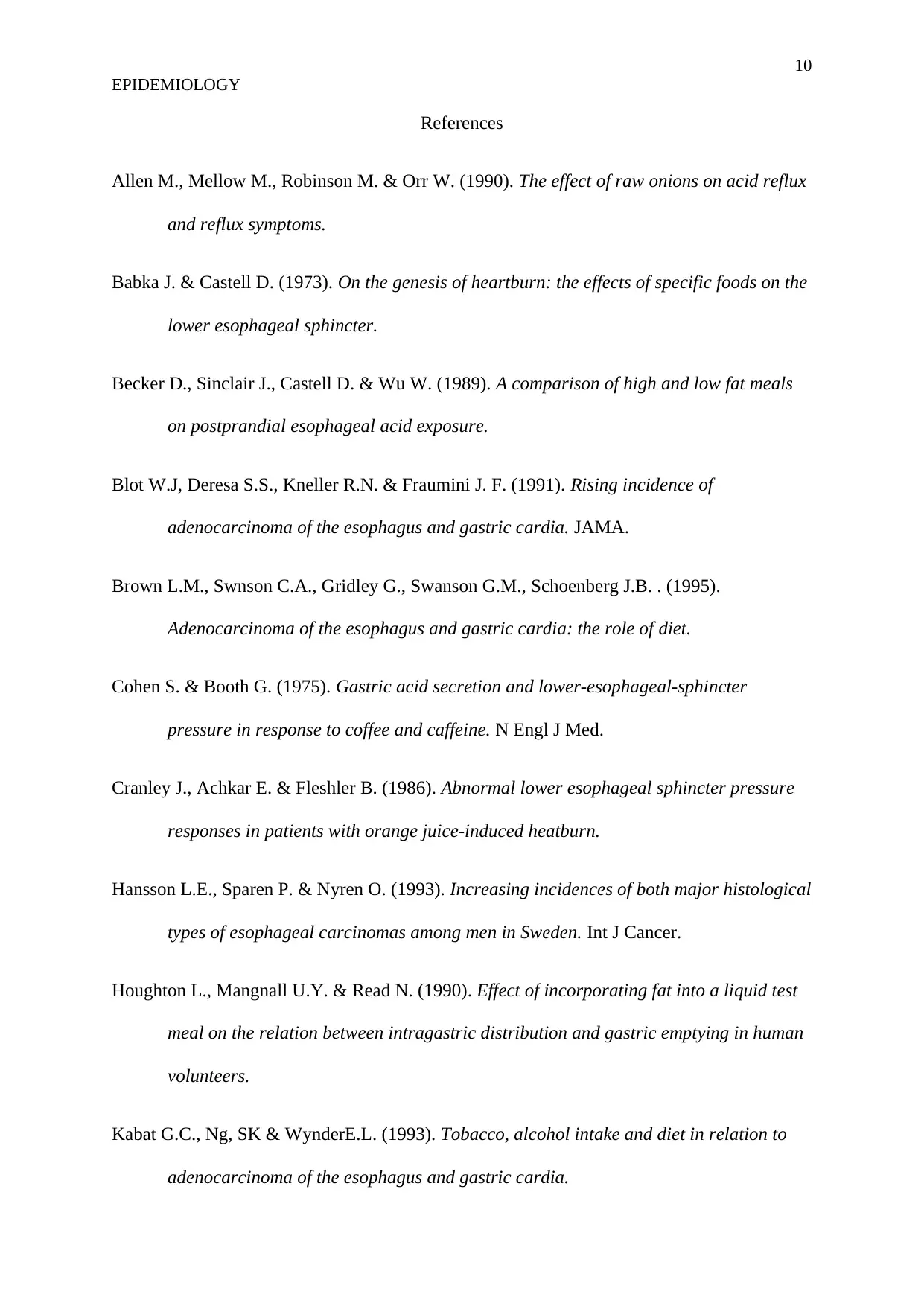
10
EPIDEMIOLOGY
References
Allen M., Mellow M., Robinson M. & Orr W. (1990). The effect of raw onions on acid reflux
and reflux symptoms.
Babka J. & Castell D. (1973). On the genesis of heartburn: the effects of specific foods on the
lower esophageal sphincter.
Becker D., Sinclair J., Castell D. & Wu W. (1989). A comparison of high and low fat meals
on postprandial esophageal acid exposure.
Blot W.J, Deresa S.S., Kneller R.N. & Fraumini J. F. (1991). Rising incidence of
adenocarcinoma of the esophagus and gastric cardia. JAMA.
Brown L.M., Swnson C.A., Gridley G., Swanson G.M., Schoenberg J.B. . (1995).
Adenocarcinoma of the esophagus and gastric cardia: the role of diet.
Cohen S. & Booth G. (1975). Gastric acid secretion and lower-esophageal-sphincter
pressure in response to coffee and caffeine. N Engl J Med.
Cranley J., Achkar E. & Fleshler B. (1986). Abnormal lower esophageal sphincter pressure
responses in patients with orange juice-induced heatburn.
Hansson L.E., Sparen P. & Nyren O. (1993). Increasing incidences of both major histological
types of esophageal carcinomas among men in Sweden. Int J Cancer.
Houghton L., Mangnall U.Y. & Read N. (1990). Effect of incorporating fat into a liquid test
meal on the relation between intragastric distribution and gastric emptying in human
volunteers.
Kabat G.C., Ng, SK & WynderE.L. (1993). Tobacco, alcohol intake and diet in relation to
adenocarcinoma of the esophagus and gastric cardia.
EPIDEMIOLOGY
References
Allen M., Mellow M., Robinson M. & Orr W. (1990). The effect of raw onions on acid reflux
and reflux symptoms.
Babka J. & Castell D. (1973). On the genesis of heartburn: the effects of specific foods on the
lower esophageal sphincter.
Becker D., Sinclair J., Castell D. & Wu W. (1989). A comparison of high and low fat meals
on postprandial esophageal acid exposure.
Blot W.J, Deresa S.S., Kneller R.N. & Fraumini J. F. (1991). Rising incidence of
adenocarcinoma of the esophagus and gastric cardia. JAMA.
Brown L.M., Swnson C.A., Gridley G., Swanson G.M., Schoenberg J.B. . (1995).
Adenocarcinoma of the esophagus and gastric cardia: the role of diet.
Cohen S. & Booth G. (1975). Gastric acid secretion and lower-esophageal-sphincter
pressure in response to coffee and caffeine. N Engl J Med.
Cranley J., Achkar E. & Fleshler B. (1986). Abnormal lower esophageal sphincter pressure
responses in patients with orange juice-induced heatburn.
Hansson L.E., Sparen P. & Nyren O. (1993). Increasing incidences of both major histological
types of esophageal carcinomas among men in Sweden. Int J Cancer.
Houghton L., Mangnall U.Y. & Read N. (1990). Effect of incorporating fat into a liquid test
meal on the relation between intragastric distribution and gastric emptying in human
volunteers.
Kabat G.C., Ng, SK & WynderE.L. (1993). Tobacco, alcohol intake and diet in relation to
adenocarcinoma of the esophagus and gastric cardia.
Paraphrase This Document
Need a fresh take? Get an instant paraphrase of this document with our AI Paraphraser
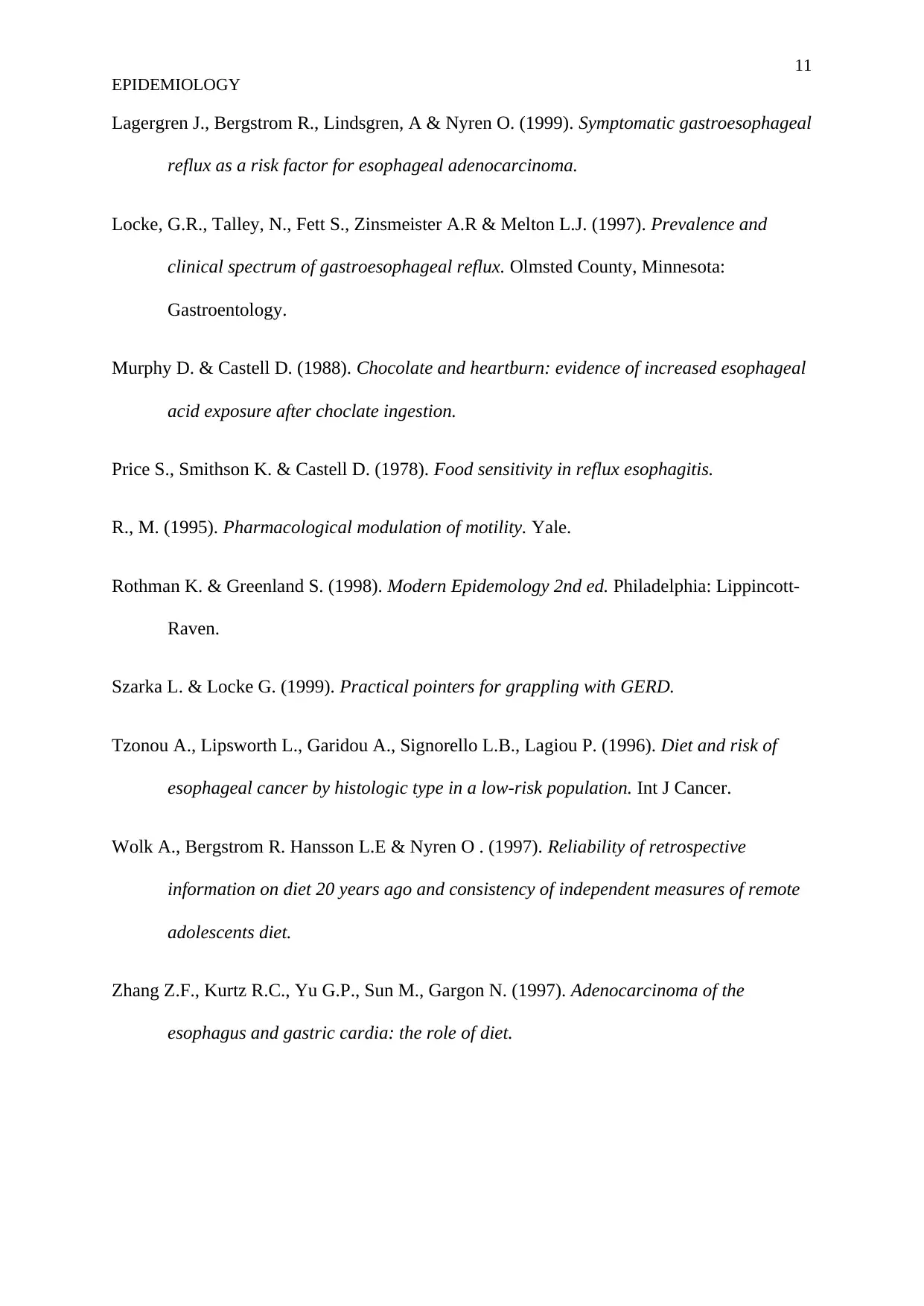
11
EPIDEMIOLOGY
Lagergren J., Bergstrom R., Lindsgren, A & Nyren O. (1999). Symptomatic gastroesophageal
reflux as a risk factor for esophageal adenocarcinoma.
Locke, G.R., Talley, N., Fett S., Zinsmeister A.R & Melton L.J. (1997). Prevalence and
clinical spectrum of gastroesophageal reflux. Olmsted County, Minnesota:
Gastroentology.
Murphy D. & Castell D. (1988). Chocolate and heartburn: evidence of increased esophageal
acid exposure after choclate ingestion.
Price S., Smithson K. & Castell D. (1978). Food sensitivity in reflux esophagitis.
R., M. (1995). Pharmacological modulation of motility. Yale.
Rothman K. & Greenland S. (1998). Modern Epidemology 2nd ed. Philadelphia: Lippincott-
Raven.
Szarka L. & Locke G. (1999). Practical pointers for grappling with GERD.
Tzonou A., Lipsworth L., Garidou A., Signorello L.B., Lagiou P. (1996). Diet and risk of
esophageal cancer by histologic type in a low-risk population. Int J Cancer.
Wolk A., Bergstrom R. Hansson L.E & Nyren O . (1997). Reliability of retrospective
information on diet 20 years ago and consistency of independent measures of remote
adolescents diet.
Zhang Z.F., Kurtz R.C., Yu G.P., Sun M., Gargon N. (1997). Adenocarcinoma of the
esophagus and gastric cardia: the role of diet.
EPIDEMIOLOGY
Lagergren J., Bergstrom R., Lindsgren, A & Nyren O. (1999). Symptomatic gastroesophageal
reflux as a risk factor for esophageal adenocarcinoma.
Locke, G.R., Talley, N., Fett S., Zinsmeister A.R & Melton L.J. (1997). Prevalence and
clinical spectrum of gastroesophageal reflux. Olmsted County, Minnesota:
Gastroentology.
Murphy D. & Castell D. (1988). Chocolate and heartburn: evidence of increased esophageal
acid exposure after choclate ingestion.
Price S., Smithson K. & Castell D. (1978). Food sensitivity in reflux esophagitis.
R., M. (1995). Pharmacological modulation of motility. Yale.
Rothman K. & Greenland S. (1998). Modern Epidemology 2nd ed. Philadelphia: Lippincott-
Raven.
Szarka L. & Locke G. (1999). Practical pointers for grappling with GERD.
Tzonou A., Lipsworth L., Garidou A., Signorello L.B., Lagiou P. (1996). Diet and risk of
esophageal cancer by histologic type in a low-risk population. Int J Cancer.
Wolk A., Bergstrom R. Hansson L.E & Nyren O . (1997). Reliability of retrospective
information on diet 20 years ago and consistency of independent measures of remote
adolescents diet.
Zhang Z.F., Kurtz R.C., Yu G.P., Sun M., Gargon N. (1997). Adenocarcinoma of the
esophagus and gastric cardia: the role of diet.
1 out of 11
Related Documents
Your All-in-One AI-Powered Toolkit for Academic Success.
+13062052269
info@desklib.com
Available 24*7 on WhatsApp / Email
![[object Object]](/_next/static/media/star-bottom.7253800d.svg)
Unlock your academic potential
Copyright © 2020–2025 A2Z Services. All Rights Reserved. Developed and managed by ZUCOL.





